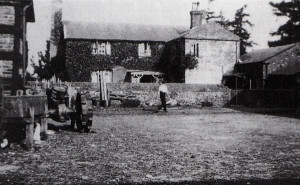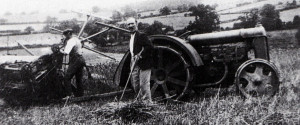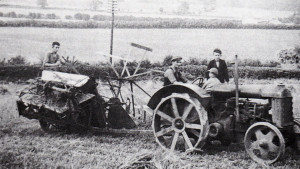
Many people of my generation will have memories of life on the land, and my early years at Ryefield were filled with small incidents which have stayed fresh in my mind for all these years.
At milking time, the little Lister engine would be started up to drive the water pump, ready to cool the milk as it was brought fresh and warm into the dairy. I’d sneak inside, and when the cooler had almost filled the chum I’d skim the froth off the top with my finger. I was never caught doing this.
Once, when we were having dinner, there was an almighty bang outside. My uncle had left his jacket on the wall and the scorching sun had set off a cartridge in the pocket. The jacket was quickly dumped into the nearest cattle trough to prevent any more exploding!
Then there was the time I went into training for the Olympics. After visiting the stables, I was about to return to the house when I was confronted by a flock of geese coming round the end of the building. Running flat out, I managed to beat them to the scullery yard gate. At about four years old, I thought the 50-yard dash wasn’t bad, and the geese were left squawking and kicking up a din outside.
Tractors figure large in my memories, the earliest being of sitting on a pile of sacks on my father’s tractor while he was ploughing. I’d sit on the axle facing backwards and watch the plough turning over the soil. The furrows had to be straight and level, with good starting and good finishing of the lands.
My mother had died when I was only ten months old, and sadly for me my early days at
Ryefield Farm came to an end when I was five and my father re-married. We moved to one of the cottages on the farm. The cowman used to live in another which also belonged to the farm.
Before my own tractor-driving days I remember walking behind dad, mower and horses when he was cutting hay. When harvest time came along, I’d walk behind the tractor and binder. This didn’t last too long because a baby brother came along and I had the unpaid job of pushing him in his pram along a track to a meadow gate and back, about half a mile in each direction.
In school holidays when we lived at the cottage, dad would go to the farm early in the morning for milking, taking me part of the way, then I’d go into a meadow to pick mushrooms and take them home. When my father returned we’d have a hearty breakfast of egg, bacon, mushrooms and fried bread. The mushrooms in the shops today never seem to taste as good as those did.

I don’t remember too much about the earlier tractors on the farm, so perhaps readers could identify them from the pictures. The tractors had long, flowing mudguards and a tool box, and all were Fordsons. When I came home from school one day dad popped in for some tea and there was a brand new orange Fordson in shiny new paint outside. The smell of the paint as it was burning off (I don’t know if they dipped them in a tank of paint as it seemed to be on everything) and the newly-turned soil just captivated me. I didn’t know then that this would be the tractor I would cut my teeth on learning to drive, but it was.
I must have eight or nine when I was first given some tractor-driving instruction. By the time I was 12 I was driving a tractor, cutting com and ploughing. Sadly I don’t have a photograph of this particular Fordson,
which was green and had rubber tyres. The orange tractor I mentioned earlier was followed by a green one in the early war years, and by 19431 was driving that one.
One day we were cutting com when the local gamekeeper started to wave his arms about alarmingly. When we stopped, we found that the string box had fallen off and was lying about 50 yards behind us. To our amazement, up to that point the binder had still been tying the sheaves!
Another incident in the same field happened when, on my return from school, I took dad a cup of tea. He was just finishing ploughing the field so he gave me a ride. As he went round for the last time the tractor spluttered to a stop because he’d driven so close to some bushes they’d turned the fuel off!
Earlier I mentioned the string box falling off the binder. On another occasion the frame cracked where the drive for the connecting rod went through, and because it was
wartime parts were hard to come by. Dad and uncle wrapped a chain around it, and made such a goodjob they had trouble removing it when the new part arrived.
My cousin and the cowman were the other team on tractor and binder when we were corn-cutting, and in one field they had stopped because the string had broken. We caught them up and were about to start again wfhen a rabbit came from under their binder, ran past us and made a dash for the hedgerow. The cowman, who had his gun handy, picked it up, turned round and fired wildly at the disappearing rabbit, bringing down a handful of leaves from a tree some ten to twelve feet above where the rabbit had entered the hedge.
The cowman, poor chap, had a stutter, and one morning when we were milking he told us another story of an escaping rabbit. He’d crept up on one that morning, taking aim he fired “and the b..b..b..beggaring thing got up and ran away!” He said he was so certain he
had had it in his sights.

When we’d finished the cutting, various people were bringing the rabbits that had been caught and laying them down to be counted when suddenly one got up and hightailed it into the sunset!
Memories of threshing at Ryefield also spring to mind. I remember watching the steam engine working away with the drum in the bam, then when evening came the engine would stand there quietly hissing and crackling away.
In wartime the War AG would do the threshing. At first the tractor used was an Oliver 90, then a Field-Marshall. To start the big single cylinder-engined Marshall took the driver and two land girls to swing it over on the handle. When the weather was frosty the orange Fordson was started, belted up pulley to pulley, and the Marshall was started that way.
In the rick yard behind the bam, when the rick had almost been threshed, I remember trying to catch the mice as they made a dash for freedom. The funniest thing was the ducks, which would also wait for the mice. Sometimes several mice would come out at the same time, but all the ducks w’ould chase after the same one. The lucky one that caught the mouse would then run to the duck pond, dabble it in the water and swrallow it. The chickens also would join in the hunt for the mice, but the ducks seemed to have it down to a fine art!
It was in the rick yard where I learned the pain of blisters, as in later years I’d have to work on the ricks, and in those days no-one bothered about protecting his hands with gloves.
One final vivid memory will remain with me for ever. One day, when we were threshing, we could see in the distant sky some bombers flying in formation towards us. Suddenly two of them collided and came crashing down, and sadly not all the crew managed to escape,
Kenneth C Orchard








